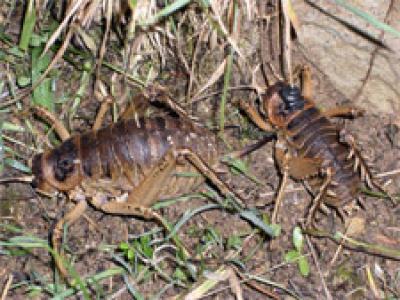The male 'does not manage the distance' to find a partner
Finding a mate can be a hard work, the giant night cricket Cook Strait, Deinacrida rugosa, is a living testament to that. This animal was found in New Zealnad and is one of the largest weight insects in the world, females can weigh up to 20g, twice the average size of a male.
In the actual study of Maud Island, New Zealand, published in the September issue of The American Naturalist magazine, evolutionary biologists at the University of Toronto in Mississauga found that the weta male crickets The task of finding partners must move a lot every night. It is worth noting that, light weight and longer legs are beneficial for male movement. Clint Kelly, Luc Busièrem and Darryl Gwynne found that males can move more than 90 meters each night to find a mate - equivalent to about 7000m in humans.

A pair of giant weta crickets, in which males are tagged with radio cards on their backs.(Photo: Darryl T. Gwynne)
Kelly and colleagues gathered unprecedented insights into the weta habit of finding partners by tracking them through radio equipment for several days. From there they can calculate the distance traveled by males and identify objects that each male and female 'often meets'.
Because the male weta crickets mate many times with their partners for a day, biologists can calculate the amount of semen transmitted by counting the number of empty packages (sperm bundles) placed under the pair of crickets. Males move twice as many females, and males in light, longer legs move longer, have more sexual partners, and transmit more sperm bundles to females (there are no characteristics at all). in children shows movement or the ability to succeed in finding partners).
Kelly said: 'Our findings are rare evidence of sexual selection that highlights the characteristics that promote mobility in just one gender. This is a very interesting phenomenon because it shows that sexual selection for smaller, more flexible males may be the cause of the incredible difference in body size in this animal. ' More importantly, this phenomenon may help explain why males are smaller than females in some other animals.
Reference: Clint D. Kelly, Luc F. Bussière, and Darryl T. Gwynne, "Sexual Selection for Male Mobility in a Giant Insect with Female-Biased Size Dimorphism."American Naturalist (2008) 172: 417-423.
- 'Scanning the brain' to find the right partner
- The stalled male horse revives his dying partner
- The more the partner screamed, the more male the monkey loved
- Seagulls lonely 10 years to find a partner
- Extinguish desire to keep your partner
- New species appear depending on how the female chooses the male
- Male spiders keep the network by tying their partners when mating
- The female tree 'expresses' consent or rejects male plants
- 'Soi' scorpion flies have violent sex life
- The 100-year-old female turtle left home for more than 10km to find a partner
- The dog is loyal to his partner
- Giant octopus is not mated because it is easy to eat mates
 Why do potatoes have eyes?
Why do potatoes have eyes? 'Tragedy' the world's largest carnivorous life: Death becomes ... public toilet
'Tragedy' the world's largest carnivorous life: Death becomes ... public toilet Tomatoes were once considered 'poisonous' for 200 years
Tomatoes were once considered 'poisonous' for 200 years Detecting microscopic parasites on human face
Detecting microscopic parasites on human face